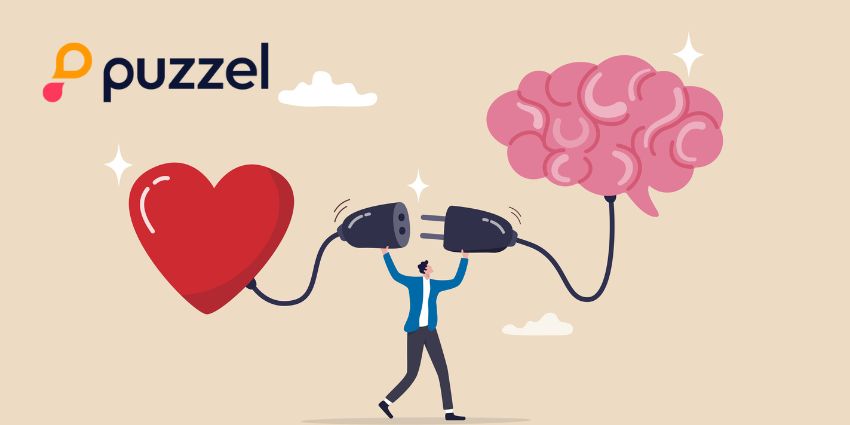AI has long since evolved from some distant contact center promise and is already reshaping the way businesses operate.
But adoption isn’t a simple on/off switch. While some teams are embedding AI deep into their workflows, others are still figuring out where to start.
‘What solutions do we need?’, ‘Is AI the best fit for us?’, ‘Where do we even start?’, ‘How long will it take?’ – these are the questions that surface time and again during AI implementation.
To help demystify a process that can often feel overly complicated, Puzzel has developed the AI Maturity Curve: a five-stage model designed to help organizations understand where they stand, and what it’ll take to move forward.
From Curiosity to Capability: What AI Maturity Really Means
Ask ten businesses how they use AI, and you’ll get ten different answers.
For Jesper Jønsson, Director of Product for AI at Puzzel, the real question isn’t just whether AI is in play, but how deeply it’s woven into a company’s daily operations.
“It’s about how effectively AI supports your day-to-day operations,” he says.
“Some teams are just dipping a toe in. Others are using it to surface real-time insights and unlock measurable value.”
Here’s how Puzzel defines the five stages of the AI Maturity Curve:
- AI Beginners are at the starting line, often working with on-premise systems and minimal AI exposure. There’s curiosity, but real barriers around infrastructure or internal knowledge.
- AI Explorers have started experimenting. Think one-off chatbots, early trials of GenAI tools like ChatGPT, or limited co-pilot deployments. Progress is happening, but often in silos.
- AI Practitioners begin to scale. Tools like conversational intelligence and agent co-pilots are deployed more consistently, helping streamline processes and build internal buy-in.
- AI Advancers connect the dots. Virtual agents are integrated with backend systems, enabling end-to-end resolutions. The focus shifts from experimentation to automation at scale.
- AI Visionaries use AI as a strategic pillar, driving innovation, surfacing customer insights, and tying everything back to business impact.
While the ‘AI Visionary’ stage is certainly alluring, getting to this stage and staying there is rare, as Jønsson explains:
“We’ve seen organizations try to go all-in on AI too quickly and stumble. You have to build it up in steps.”
Where Are You on the Curve … And Why?
Knowing your current position is one thing, but understanding why you’re there, and what it takes to move up, is where the real opportunity lies.
For many companies stuck in the early stages, legacy tech is the biggest anchor.
Older platforms, not designed with AI in mind, clash with modern tools. At the same time, others are held back by foundational gaps, like the lack of a centralized, structured knowledge base to train virtual agents.
Jønsson details how some businesses struggle with the “myth that AI is plug-and-play.
“If you don’t have clean, well-organized information behind the scenes, even the best AI will fall short.”
Culture is another major hurdle.
You can have cutting-edge tools, but without internal champions or the right change management, progress stalls.
AI isn’t just a tech upgrade; it often requires a rethink of how teams collaborate.
Why Progress Matters: From Insight to Impact
For organizations that tackle these blockers and climb the curve, the payoff is significant.
Beyond the obvious promise of greater efficiency, advancing AI maturity allows the contact center to be viewed in a different light – not as a cost center, but as a rich source of customer intelligence.
“Every conversation is an opportunity to learn,” says Jønsson.
“If you can capture and act on those insights at scale, it transforms your entire approach to customer service.”
So, where do you start?
For Jønsson, one low-risk, high-impact entry point is Conversational Intelligence (CI).
Unlike virtual agents, which interact directly with customers, CI runs in the background, analyzing conversations, spotting trends, and surfacing opportunities for improvement.
“As businesses embrace CI, they start seeing patterns they couldn’t detect before,” Jønsson explains.
“That can inform training, process design, and even product development.”
Still, he is quick to warn against going too big, too fast, cautioning businesses to set achievable, realistic goals:
“Automating just 3-5 percent of your interactions can make a meaningful difference. You don’t need to jump straight to 50 percent. That’s often where projects derail.”
Don’t Just Deploy – Climb
AI maturity isn’t a status symbol; it’s a journey. And every journey needs a clear starting point and destination.
With Puzzel’s AI Maturity Curve, businesses can pinpoint their current stage and map out the steps needed to level up.
You can learn more about Puzzel’s AI Maturity Curve and the company’s full suite of solutions by visiting their website today.
You can also gain additional insights into unlocking real contact center value by watching this exclusive interview with Jesper Jønsson, Director of Product for AI at Puzzel.







